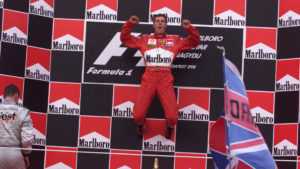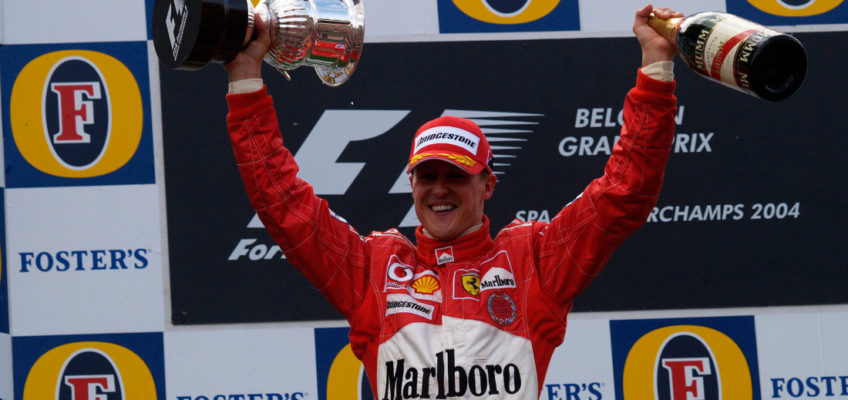Michael Schumacher, one of the greatest legends of Formula 1, turns 50 today. On such a special day we want to pay him a well-deserved tribute by remembering some of his most memorable performances. Very few drivers have left such an impressive legacy in F1 as ‘the Kaiser’.
The former driver was born on January the 3rd, 1969 in Hürth-Hermülheim, West Germany. After the death of Ayrton Senna in 1994, the German driver took his place on the F1 throne and a new star was born.
His first appearance in a World Championship marked the arrival of a new generation of F1 drivers that would replace the illustrious Senna, Prost, Mansell or Piquet. From the mid-90s to the mid-2000s, Schumacher was the golden bar of F1.
His particular talent, coupled with an aggressive driving style, made him an unbeatable opponent. He starred in some of the most unforgettable duels with other stars such as Mikka Hakkinen in the late ’90s, Juan Pablo Montoya and Fernando Alonso.
All of this made him the greatest icon in the Olympus of Speed. We stand before one of the world’s most exceptional figures not only of Formula 1 but of sports in general.
Michael Schumacher’s achievements in Formula 1
Michael Schumacher took part in a total of 307 Grands Prix during 19 seasons with the teams Jordan, Benetton, Ferrari, and Mercedes. He obtained 91 victories (29.64%), 155 podiums (50.49%), 68 pole positions (22.15%), 77 fastest laps (25.08%) and a total of 1,566 points.
Over the course of his career, he broke many records including being the driver with the most world titles, seven in total, a record that still stands today. He conquered his seven crowns with Benetton (1994, 1995) and Ferrari (2000-2004).
He also became the driver with the most top positions in qualifying since Ayrton Senna. As if that was not enough, he led an F1 race for a total of 5,111 laps and 24,148 km.
Belgium 1991: Michael Schumacher debuts in replacement of a jailed driver
Michael Schumacher’s Formula 1 debut came by chance. Bertrand Gachot, the leading driver in the new Jordan team, took a leisurely trip to London with his girlfriend before the Belgian Grand Prix of 1991 which was scheduled for the 25th of August.
The romantic weekend ended up with Gachotd in prison after he used a self-defense spray banned in the UK when he was supposedly attacked by a taxi driver.
Eddie Jordan, desperate having his lead driver in prison, accepted the risky proposal from Willi Webber to use 22-year-old Schumacher as a replacement.
Webber reassured the British boss that his candidate had experience behind the wheel of an F1 car, a fact which was of course, not true. But the inexperienced German rookie dazzled all the fans at the Spa-Francorchamps.
He came seventh at the qualifying round, leaving his partner Andrea De Cesaris, eleventh despite the latter having plenty of experience with the car.
By the first corner (La Source), he was in fifth position just before his clutch gave in. After that exhibition, he was signed by Benetton for the rest of the season onboard the B191.
Belgium 1992: First victory
After three podiums with the Benetton B191 and another two with the B192, Michael Schumacher got his first victory on the twelfth race of 1992. It was the 30th of August at the Belgian Grand Prix, again at the Spa-Francorchamps Circuit.
Soon after it started to rain and cars went to pits to mount wet tires. As the asphalt dried up, Michael Schumacher’s driving lesson began. First, he climbed up to second place right behind Mansell.
Then Schumacher decided to stay on the track while the others pitted for a second time. With that risky maneuver, he took the lead and held on to it until the end. He came in 36 seconds ahead of Mansell, and 43 before Patrese.
Spain 1996: Wet masterclass and first victory with Ferrari
The Spanish Grand Prix of June the 2nd 1996 at Montmelo was without a doubt one of the best races the country has ever seen. It was Michael Schumacher’s seventh race in red.
Under a terrifying deluge, he overtook both Williams FW18s of Damon Hill and Jacques Villeneuve and the Benetton-Renaults of Jean Alesi and Gerhard Berger.
As the track turned into an ocean, the mechanical differences became less important and so emerged the Kaiser’s expert hand at “navigating” the track with his Ferrari F310. He crossed the finish line 45.302 seconds before Jean Alesi and 48.388 seconds ahead of Canadian Jacques Villeneuve.
After a bad start which saw him drop from third to sixth place, the magic began. He performed a spectacular comeback under one of the most adverse weather conditions on record.
His wild rhythm took him to the first position during lap number 12, as the rest of the drivers fell victim a sort of collective shipwreck -14 dropouts out of 20 participants-.
Hungary 1998: A victory in 20 laps
The pair composed by Michael Schumacher and Ross Brown achieved a sporting miracle in 1998. That season became an unequal battle between McLaren and Ferrari. On its 12th race on August the 16th at the Hungarian Grand Prix the Britons had had 7 victories and the Italian 3. McLaren was 16 points ahead of Ferrari.
The mechanically superior Woking cars came in first and second in the classifying round at the Hungaroring. Michael Schumacher was almost four-tenths of a second behind pole holder Hakkinen. That sort of a gap, in such a short and narrow circuit practically sentences the race before the start.

But the Schumacher-Brown duo was not ready to give up. Hakkinen kept his first position at the start with the help of his British squire, David Coulthard. The Kaiser pressured the Scot, hoping for a mistake.
Comfortably installed at the top with his teammate blocking Schumacher, the Scandinavian driver escaped. Everything seemed to be decided after the first pit stop on lap 25. Brown, however, had an extremely risky plan: a three-stop strategy.
The plan required to set a relentless pace in order to recover the time that would be lost during the extra pit stop. The strategy was meant to allow the German driver to rejoin a clear track and launch a sort of classification quest over the remaining 20 laps.

It seemed impossible. After his pit stop on lap 42, Brown told Schumacher over the radio: “Now you have 19 laps to recover 25 seconds.” The German simply replied: “OK”.
McLaren realized the move and tried to cover Coulthard’s position, who was pitting on lap 44. Hakkinen’s leading position was in danger, even more so as he was having some issues with his car.
His McLaren pitted on lap 44 knowing that if he emerged ahead of the German driver, it would be very difficult for this to overtake him. But the opposite happened.
When the Finn returned from his pit stop, he was five seconds behind Schumacher. But this was only the first part of the plan. Michael still had to stop for the third time and get a margin of about 25 seconds.
Spectators stared in disbelief. Michael didn’t waste an inch of the Magyar track signing one fast lap after another. It was a sprint race which showed the world Schumacher’s famous nerves of steel and driving magic.
The public was cheering in ecstasy. When the red missile made its third pitstop he had a 27-second cushion to fall back on. The strategy had worked.
Japan 2000: Ferrari’s first title after 21 years
Michael Schumacher would win the title in the year 2000 after the Finn Mika Hakkinen had prevented it 1998 and 1999. This would be his third title and first with Ferrari and was sealed at the Japanese Grand Prix.
The sixteenth and penultimate race of the season was held on October the 8th at the Suzuka circuit. There, Schumacher beat the McLaren-Mercedes duo of Hakkinen and David Coulthard.
It was the Prancing Horse’s first victory since Jody Scheckter’s in 1979. A 21-year winless strike. It was his fifth season in Maranello where later on he would match the achievements of Jack Brabham, Jackie Stewart, Niki Lauda, Nelson Piquet and Ayrton Senna. The legend of the Red Baron had begun.
Japan 2003: Michael beats Fangio’s five title record
Michael Schumacher arrived at the last of 2003 races, the Japanese Grand Prix, with the title at stake. He was nine points ahead of Kimi Raikkonen (McLaren-Mercedes) and ten before Colombian driver Juan Pablo Montoya (Williams-Ford).
In a tactical race, german driver finished in eighth position and two points ahead of the Finn. It was in this way that he won his sixth crown, his fourth consecutive one with Ferrari, breaking the five-title record of the Argentinean Juan Manuel Fangio, which he had held since 1957.
San Marino 2006: Schumacher beat Senna’s 65 pole record
Already a legend, Michael Schumacher was statistically off the F1 charts, but there was one record left to break. At the San Marino Grand Prix of 2006, at the controls of his Ferrari 248, he was the fastest at the Ímola classification round with 1: 22.795.
It was his 66th pole position, one more than those obtained by another legend; Ayrton Senna. He had now broken all of the F1’s legendary records.
Of course we end this article by saying: Keep fighting, Michael!
Images: Ferrari.com





Leave a Reply